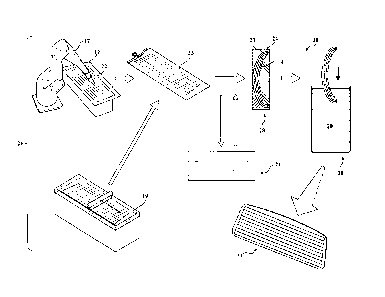Some of the information on this Web page has been provided by external sources. The Government of Canada is not responsible for the accuracy, reliability or currency of the information supplied by external sources. Users wishing to rely upon this information should consult directly with the source of the information. Content provided by external sources is not subject to official languages, privacy and accessibility requirements.
Any discrepancies in the text and image of the Claims and Abstract are due to differing posting times. Text of the Claims and Abstract are posted:
| (12) Patent Application: | (11) CA 3072675 |
|---|---|
| (54) English Title: | DEFROST/HEATING SOLUTION FOR GLAZED POLYCARBONATE |
| (54) French Title: | SOLUTION DE DEGIVRAGE/CHAUFFAGE POUR POLYCARBONATE VERNI |
| Status: | Examination |
| (51) International Patent Classification (IPC): |
|
|---|---|
| (72) Inventors : |
|
| (73) Owners : |
|
| (71) Applicants : |
|
| (74) Agent: | GOWLING WLG (CANADA) LLP |
| (74) Associate agent: | |
| (45) Issued: | |
| (22) Filed Date: | 2020-02-13 |
| (41) Open to Public Inspection: | 2020-08-15 |
| Examination requested: | 2022-09-26 |
| Availability of licence: | N/A |
| Dedicated to the Public: | N/A |
| (25) Language of filing: | English |
| Patent Cooperation Treaty (PCT): | No |
|---|
| (30) Application Priority Data: | ||||||
|---|---|---|---|---|---|---|
|
A plastic polycarbonate film is silk screen printed or printed with a robotic
application or any other printing application, with a defrost grid composed
from a
flexible circuit of a silver or other thermoformable conductive inks and then
trimmed/die cut to size. Once the plastic decoration is trimmed to size it is
placed into an injection mold. In the molding process, the decorated insert is
placed into the cavity or onto the core of an injection mold that has been
designed for in-mold decorating. The desired molding resin is shot behind or
over
the insert, bonding its surface to the decorated insert and forming an
integral
finished part.
Note: Claims are shown in the official language in which they were submitted.
Note: Descriptions are shown in the official language in which they were submitted.

2024-08-01:As part of the Next Generation Patents (NGP) transition, the Canadian Patents Database (CPD) now contains a more detailed Event History, which replicates the Event Log of our new back-office solution.
Please note that "Inactive:" events refers to events no longer in use in our new back-office solution.
For a clearer understanding of the status of the application/patent presented on this page, the site Disclaimer , as well as the definitions for Patent , Event History , Maintenance Fee and Payment History should be consulted.
| Description | Date |
|---|---|
| Amendment Received - Response to Examiner's Requisition | 2024-05-24 |
| Amendment Received - Voluntary Amendment | 2024-05-24 |
| Examiner's Report | 2024-02-20 |
| Inactive: Report - QC passed | 2024-02-19 |
| Letter Sent | 2022-11-29 |
| All Requirements for Examination Determined Compliant | 2022-09-26 |
| Request for Examination Requirements Determined Compliant | 2022-09-26 |
| Request for Examination Received | 2022-09-26 |
| Revocation of Agent Request | 2021-03-19 |
| Change of Address or Method of Correspondence Request Received | 2021-03-19 |
| Appointment of Agent Request | 2021-03-19 |
| Common Representative Appointed | 2020-11-07 |
| Inactive: COVID 19 - Deadline extended | 2020-08-19 |
| Application Published (Open to Public Inspection) | 2020-08-15 |
| Inactive: Cover page published | 2020-08-14 |
| Inactive: COVID 19 - Deadline extended | 2020-08-06 |
| Letter Sent | 2020-07-31 |
| Inactive: COVID 19 - Deadline extended | 2020-07-16 |
| Inactive: COVID 19 - Deadline extended | 2020-07-02 |
| Inactive: COVID 19 - Deadline extended | 2020-06-10 |
| Inactive: COVID 19 - Deadline extended | 2020-05-28 |
| Inactive: COVID 19 - Deadline extended | 2020-05-14 |
| Inactive: COVID 19 - Deadline extended | 2020-04-28 |
| Inactive: COVID 19 - Deadline extended | 2020-03-29 |
| Inactive: Correspondence - Transfer | 2020-03-27 |
| Inactive: IPC assigned | 2020-03-04 |
| Inactive: IPC removed | 2020-03-04 |
| Inactive: IPC assigned | 2020-02-27 |
| Inactive: IPC assigned | 2020-02-27 |
| Inactive: IPC assigned | 2020-02-27 |
| Inactive: IPC assigned | 2020-02-27 |
| Inactive: IPC assigned | 2020-02-27 |
| Inactive: First IPC assigned | 2020-02-27 |
| Inactive: IPC assigned | 2020-02-27 |
| Inactive: IPC assigned | 2020-02-27 |
| Inactive: IPC assigned | 2020-02-27 |
| Letter sent | 2020-02-26 |
| Filing Requirements Determined Compliant | 2020-02-26 |
| Priority Claim Requirements Determined Compliant | 2020-02-25 |
| Request for Priority Received | 2020-02-25 |
| Common Representative Appointed | 2020-02-13 |
| Inactive: Pre-classification | 2020-02-13 |
| Application Received - Regular National | 2020-02-13 |
| Inactive: QC images - Scanning | 2020-02-13 |
There is no abandonment history.
The last payment was received on 2023-12-07
Note : If the full payment has not been received on or before the date indicated, a further fee may be required which may be one of the following
Please refer to the CIPO Patent Fees web page to see all current fee amounts.
| Fee Type | Anniversary Year | Due Date | Paid Date |
|---|---|---|---|
| Application fee - standard | 2020-02-13 | 2020-02-13 | |
| MF (application, 2nd anniv.) - standard | 02 | 2022-02-14 | 2022-01-24 |
| Request for examination - standard | 2024-02-13 | 2022-09-26 | |
| MF (application, 3rd anniv.) - standard | 03 | 2023-02-13 | 2022-12-14 |
| MF (application, 4th anniv.) - standard | 04 | 2024-02-13 | 2023-12-07 |
Note: Records showing the ownership history in alphabetical order.
| Current Owners on Record |
|---|
| MAGNA EXTERIORS INC. |
| Past Owners on Record |
|---|
| PINELOPI THANOU |